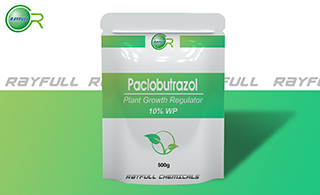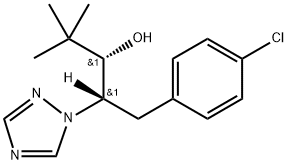 |
| HOME > Plant Growth Regulator |
| Name Of Product |
CAS NO. |
Specification |
MSDS |
| Paclobutrazol |
76738-62-0 |
95% TC, 10% WP, 15% WP |

|
|
|
Paclobutrazol Basic information
|
|
Product Name:
|
Paclobutrazol
 
|
|
Synonyms:
|
(2RS,3RS)-1-(4-Chlorophenyl)-4,4-dimethyl-2-(1H-1,2,4-triazol-1-yl)pentan-3-ol;(r*,r*)-(+-)-thyl);1h-1,2,4-triazole-1-ethanol,beta-((4-chlorophenyl)methyl)-alpha-(1,1-dimethyle;2,4-Triazole-1-ethanol,.beta.-[(4-chlorophenyl)methyl]-.alpha.-(1,1-dimethylethyl)-,(R*,R*)-(±)-1H-1;Culter;duoxiaozuo;Paclobutrazol(Pp333);1H-1,2,4-Triazole-1-ethanol, .beta.-(4-chlorophenyl)methyl-.alpha.-(1,1-dimethylethyl)-, (.alpha.R,.beta.R)-rel-
|
|
CAS:
|
76738-62-0
|
|
MF:
|
C15H20ClN3O
|
|
MW:
|
293.8
|
|
EINECS:
|
616-379-6
|
|
Product Categories:
|
Pesticide intermediates;NULL;PLANT GROWTH REGULATOR;Pharmaceutical intermediates;Chemical
|
|
Mol File:
|
76738-62-0.mol
|
|

|
|
|
|
Paclobutrazol Chemical Properties
|
|
Hazard Codes
|
Xn,F
|
|
Risk Statements
|
22-21/22-11
|
|
Safety Statements
|
36
|
|
RIDADR
|
UN1325 4.1/PG 2
|
|
WGK Germany
|
3
|
|
RTECS
|
XZ4803300
|
|
HazardClass
|
4.1
|
|
PackingGroup
|
II
|
|
HS Code
|
29339900
|
|
|
|
Paclobutrazol Usage And Synthesis
|
|
Chemical properties
|
The pure product appears as white crystalline solid with a M.p. of 165-166 ?C, a relative density of 1.22 and a vapor pressure of 1x10-6 Pa) (20?C), 8X10-6 Pa) (30?C), and 0.1 Pa at 20? have also been reported. The solubility at 20?C: methanol: 150 g/L; acetone:110 g/L; methylene chloride 100 g/L; hexane 10 g/L; xylene: 60 g/L; water 35 mg/L; Cyclohexanone: 180 g/L, respectively. Partition coefficient (n-octanol/water): 1590. Pure product is stable at 50 ℃ for 6 months with the aqueous solution being stable at room temperature for more than 30d, being relative stable against UV.
|
|
Uses
|
1. Paclobutrazol belongs to azole plant growth regulators, being the biosynthetic inhibitors of the endogenous gibberellin. It has effects of hindering plant growth and shortening the pitch. For example, being used in rice can improve the activity of indole acetic acid oxidase, reduce the level of endogenous IAA in rice seedlings, significantly control the growth rate of the top of the rice seedlings, promote leaf, make the leaves dark green, the root system developed, reduce the lodging and increase the production amount. The general control rate is up to 30%; leaf promotion rate is 50% to 100%, and the production increase rate is 35%. Being used in peach, pear, citrus, apples and other fruit trees can be used to shorten the tree. Geranium, poinsettia and some ornamental shrubs, when treated with paclobutrazol, have their plant type be adjusted, giving higher ornamental value. Cultivation of greenhouse vegetables such as tomatoes and rape gives a strong seedling effect.
2. Cultivation of late rice can strengthen the seedling, during the one-leaf/one-heart stage, dry out the seedling water in the field and apply 100~300mg/L of PPA solution for uniform spraying in 15kg/100m2. Control the excessive growth of the machine transplanting rice seedlings. Apply 150 kg of 100 mg/L paclobutrazol solution for soaking 100kg of rice seeds for 36h. Apply germination and sowing with a 35d seedling age and controlling the seedling height not higher than 25cm. When used for the branch control and fruit protection of the fruit tree, it should be usually performed in late autumn or spring with each fruit tree subjecting to injection of 500 mL of 300mg/L paclobutrazol drug solution, or subjecting to uniform irrigation along the 5~10cm place of the soil surface around the 1/2 crown radius. Apply 15% wettability powder 98g/100m2 or so. Apply the 100 m2 paclobutrazol with an active ingredient of 1.2~1.8 g/100m2, being able to shorten the base intersection of the winter wheat and strengthen the stem.
3. Paclobutrazol also has effect against the rice blast, cotton red rot, cereal smut, wheat and the rust of other crops as well as powdery mildew, etc. It can also used for fruit preservatives. In addition, within a certain amount, it also has inhibitory effect against some single, dicotyledonous weeds.
4. Paclobutrazol is a novel plant growth regulator, being able to inhibit the formation of gibberellin derivatives, reducing the plant cell division and elongation. It can be easily absorbed by roots, stems and leaves and conducted through the xylem of the plant with bactericidal effect. It has extensive activity on the Gramineae plants, being able to make the plant stems become short stalks, reduce the lodging and increase the yield.
5. It is a novel, high efficiency, low toxicity plant growth regulator with broad-spectrum bactericidal effect.
6. Fixed consumption amount of raw materials: Pinacolone: 930kg/t, 1,2,4-triazole 540kg/t, chlorobenzyl chloride 960kg/t.
|
|
Toxicity
|
The acute oral LD50 of rats was 2000mg/kg (male), 1300mg/kg (female); for mice oral: 490mg/kg (male), 1,200mg/kg (female); for rabbit, the acute oral LD50: 840 mg/kg (male), 940 mg/kg (female). Rat and rabbit: acute percutaneous LD50> 1000mg/kg. For rat, acute inhalation has a LC50: 4.79mg/L (male) (4h), 3.13mg/L (female) (4h). It has certain irritant effect on the skin and eyes of the rat and rabbit. The no-action dosage for feeding rats of 2 years is 250 mg/kg; the no-action dosage for feeding dog of 1 year is 75 mg/kg; No mutagenicity effect. For rainbow trout, LC50:27.8mg/L (96h), carp LC5023.5mg/L (48h), and Daphnia LC50> 7900mg/L. Low toxicity to bees, LD50> 0.002mg/only.
|
|
Production method
|
Preparation method one
1,2,4-triazole and 1-chloro-3,3-dimethyl-2-butanone were used as starting materials to synthesize α-1,2,4-triazole-3,3-dimethyl-2-butanone, followed with condensation reaction with chlorobenzyl chloride, generating the α-p-chlorobenzyl-1,2,4-triazole-3,3-dimethyl-2-butanone, and then followed by being reduced by sodium borohydride to get the paclobutrazol.
This method is easy to obtain raw materials with less steps less. The main drawback is that during the reduction reaction using sodium borohydride (potassium), resulting in high cost. According to the literature, the Sodium Disulfite (Na2S2O4) is used as reductant for reaction at alkaline media (NaHCO3) and the selected solvent or solvent system (water-methanol, 6: 1, volume ratio), generating paclobutrazol.
An example of the operation is as follows: 0.03 mol of NaHCO3 is mixed with 60 mL of water and heated with stirring to dissolving. Then, the chlorothiazone was completely dissolved in 10 mL methanol and then added into the aqueous solution of NaHCO3 in one time. The resulting turbid reaction mixture was heated and stirred, and the safety powder (0.03 mol) was added in 6 h in 6 h after refluxing. Perform reflux for 2h. After the end of the reaction, apply cooling, suction filtration, washing with water and drying to get paclobutrazol with the melting point of 146~154 ℃. The crude product was recrystallized from acetonitrile as a white solid with a m.p. of 162-163 ° C, product purity of 98.23%, and the yield of 98.81% base on calculation on clozapine.
Preparation method two
Take p-chlorobenzaldehyde and 3,3-dimethyl-2-butanone as the raw material to generate the corresponding ketene, with hydrogenation, bromination and reaction with 1, 2, 4-triazole, and finally reduced with boron hydride sodium to generate paclobutrazol.
This method is easy to obtain raw materials, but the process is longer.
Preparation method three
1-(p-chlorophenyl)-2-(1,2,4-triazol-1-yl) propionyl chloride is reacted with tert-butyl magnesium bromide, followed by reduction with sodium borohydride to generate paclobutrazol.
Though the production steps of this method are few, but the raw material is rare, and easy to subject to hydrolysis, need to be carried out under anhydrous conditions.
|
|
Hazards & Safety Information
|
Category: Pesticides
Toxic classification: poisoning
Acute toxicity: Oral-Rat LD50: 1300 mg/kg; Oral-mouse LD50: 490 mg/kg
Flammability and hazardous characteristics: Combustion produces toxic nitrogen oxides and chloride gases
Storage and transportation characteristics Treasury: ventilated, low temperature and dry; store it separately from food raw materials for storage and transportation
Fire extinguishing agent: dry powder, foam, sand
|
|
Uses
|
Paclobutrazol is a triazole fungicide used as an plant growth retardant in inhibiting gibberellin biosynthesis.
|
|
Uses
|
Plant growth regulator.
|
|
Agricultural Uses
|
Plant growth regulator: Used by arborists to maintain deciduous and broadleaf trees near buildings, reduce the growth of trees near power lines, and extend the longevity of trees on sites with limited natural resource.
|
|
|
|
Paclobutrazol Preparation Products And Raw materials
|
|
|
|
|







